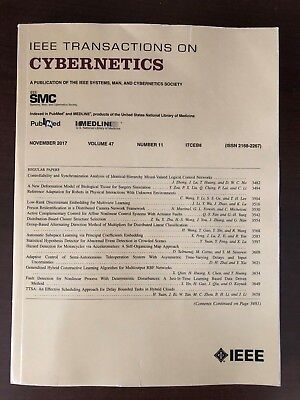基于观测器的多代理系统人在环最优输出簇同步控制:一种无模型强化学习方法
IF 9.4
1区 计算机科学
Q1 AUTOMATION & CONTROL SYSTEMS
引用次数: 0
摘要
本文章由计算机程序翻译,如有差异,请以英文原文为准。
Observer-Based Human-in-the-Loop Optimal Output Cluster Synchronization Control for Multiagent Systems: A Model-Free Reinforcement Learning Method
This article investigates the observer-based human-in-the-loop (HiTL) optimal output cluster synchronization control problem for nonlinear multiagent systems (MASs). First, the leader is designed to be nonautonomous, with the unknown time-varying input monitored by the human operator directly. To address the problem that leader’s output is not available to each follower, an observer is designed. This observer features practical prescribed-time convergence, and independence of prior knowledge of leader’s input. Then, an augmented system consisting of observer dynamics and follower dynamics is constructed and a cost function is formulated. Accordingly, the HiTL optimal output cluster synchronization control problem is transformed into a solution to the Hamilton-Jacobian–Bellman equation (HJBE). Subsequently, the off-policy reinforcement learning algorithm is utilized to learn the solution to HJBE without complete knowledge of the system dynamics. To alleviate computational burden, the single critic neural network (NN) is employed for the algorithm implementation, with the least square method applied for training the NN weights. Finally, the simulation results are presented to verify the validity of the designed control scheme.
求助全文
通过发布文献求助,成功后即可免费获取论文全文。
去求助
来源期刊

IEEE Transactions on Cybernetics
COMPUTER SCIENCE, ARTIFICIAL INTELLIGENCE-COMPUTER SCIENCE, CYBERNETICS
CiteScore
25.40
自引率
11.00%
发文量
1869
期刊介绍:
The scope of the IEEE Transactions on Cybernetics includes computational approaches to the field of cybernetics. Specifically, the transactions welcomes papers on communication and control across machines or machine, human, and organizations. The scope includes such areas as computational intelligence, computer vision, neural networks, genetic algorithms, machine learning, fuzzy systems, cognitive systems, decision making, and robotics, to the extent that they contribute to the theme of cybernetics or demonstrate an application of cybernetics principles.
 求助内容:
求助内容: 应助结果提醒方式:
应助结果提醒方式:


